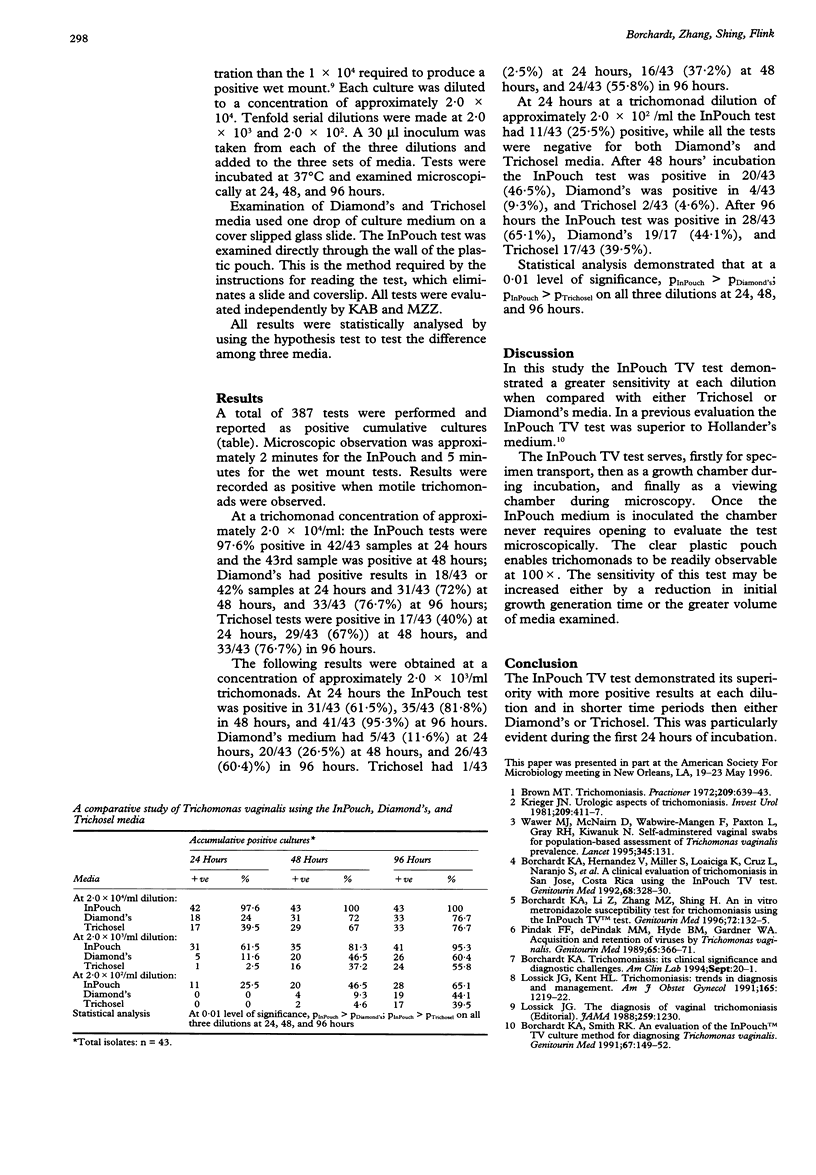Abstract
OBJECTIVE: This study compared the ability of three culture media (InPouch TV, Diamond's, and Trichosel) to support the growth of clinical isolates of Trichomonas vaginalis and their relative sensitivity for detection of the organism. METHODS: The majority of the clinical isolates were obtained from two San Francisco Bay Area clinics. T vaginalis was subcultured in 4 ml of one of the InPouch, Diamond's, or Trichosel media for 24-48 hours before evaluation. Twenty isolates were initially cultured in the InPouch test, 13 with Diamond's, and 10 with Trichosel. A haemocytometer was used to measure the initial concentrations of the organisms. Then serial dilutions were made in saline to yield approximately 2.0 x 10(4), 2.0 x 10(3), and 2.0 x 10(2) motile T vaginalis per ml. A 30 microliter inoculum from each dilution was transferred into 4 ml aliquots of the three media (387 individual tests, 43 x 3 dilutions x 3 media). Microscopic examinations for viable trichomonads were made at 24, 48, and 96 hours. Microscopy was through the pouch wall for the InPouch medium, and through a cover slipped slide with one drop of Diamond's and Trichosel media. RESULTS: At 24 hours, the InPouch demonstrated 84/129 positive, Diamond's 23/129, and Trichosel 18/129. At 48 hours, an accumulative positive rate for the InPouch was 98/129, for Diamond's 55/129, and Trichosel 47/129. At 96 hours the total positives for each test were 112/129 for the InPouch, 78/129 for Diamond's, and 74/129 for Trichosel. CONCLUSIONS: The InPouch TV test was significantly more sensitive than either Diamond's or Trichosel (at 0.01 level of significance, pInPouch > pDiamond's; pInPouch > pTrichosel on all three dilutions at 24, 48, and 96 hours). This increased sensitivity was the result of either a reduced generation time or the larger volume of media examined microscopically.
Full text
PDF

Selected References
These references are in PubMed. This may not be the complete list of references from this article.
- Borchardt K. A., Hernández V., Miller S., Loaiciga K., Cruz L., Naranjo S., Maida N. A clinical evaluation of trichomoniasis in San Jose, Costa Rica using the InPouch TV test. Genitourin Med. 1992 Oct;68(5):328–330. doi: 10.1136/sti.68.5.328. [DOI] [PMC free article] [PubMed] [Google Scholar]
- Borchardt K. A., Li Z., Zhang M. Z., Shing H. An in vitro metronidazole susceptibility test for trichomoniasis using the InPouch TV test. Genitourin Med. 1996 Apr;72(2):132–135. doi: 10.1136/sti.72.2.132. [DOI] [PMC free article] [PubMed] [Google Scholar]
- Borchardt K. A., Smith R. F. An evaluation of an InPouch TV culture method for diagnosing Trichomonas vaginalis infection. Genitourin Med. 1991 Apr;67(2):149–152. doi: 10.1136/sti.67.2.149. [DOI] [PMC free article] [PubMed] [Google Scholar]
- Brown M. T. Trichomoniasis. Practitioner. 1972 Nov;209(253):639–644. [PubMed] [Google Scholar]
- Krieger J. N. Urologic aspects of trichomoniasis. Invest Urol. 1981 May;18(8):411–417. [PubMed] [Google Scholar]
- Lossick J. G. The diagnosis of vaginal trichomoniasis. JAMA. 1988 Feb 26;259(8):1230–1230. [PubMed] [Google Scholar]
- Pindak F. F., Mora de Pindak M., Hyde B. M., Gardner W. A., Jr Acquisition and retention of viruses by Trichomonas vaginalis. Genitourin Med. 1989 Dec;65(6):366–371. doi: 10.1136/sti.65.6.366. [DOI] [PMC free article] [PubMed] [Google Scholar]
- Wawer M. J., McNairn D., Wabwire-Mangen F., Paxton L., Gray R. H., Kiwanuka N. Self-administered vaginal swabs for population-based assessment of Trichomonas vaginalis prevalence. Lancet. 1995 Jan 14;345(8942):131–132. doi: 10.1016/s0140-6736(95)90100-0. [DOI] [PubMed] [Google Scholar]


